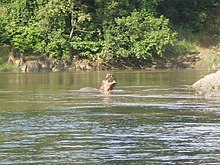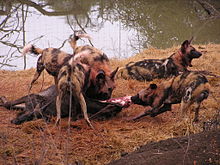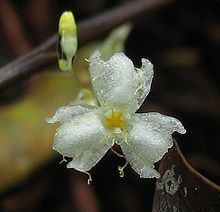List of protected areas of Cameroon

The protected areas of Cameroon include national parks, wildlife sanctuaries, faunal reserves, and one flora sanctuary. Many protected areas in Cameroon are still in pristine condition, mostly because there is less tourism in Cameroon than other regions of Africa.[1] According to reported statistics, there were ten protected areas from 1932 to 1960. Six protected areas were added between 1960 and 1980, five more were added between 1980 and 2004, and eight protected areas are under consideration within a final approval process.[2]
National parks
19 national parks have been established in Cameroon.[3]
- Bakossi National Park (293 km2), est. 2007
- Bénoué National Park (1,979 km2), est. 1968
- Bouba Njida National Park (2,114 km2), est. 1968
- Boumba Bek National Park (2,362 km2), est. 2005
- Campo Ma'an National Park (2609.44 km2), est. 2000
- Deng Deng National Park (687.35 km2), est. 2013
- Douala Edéa National Park (2715 km2), est. 2018
- Faro National Park (3,500 km2), est. 2008
- Kimbi-Fungom National Park (989.8 km2), est. 2015
- Korup National Park (1,261 km2), est. 1986
- Lobéké National Park (2153 km2), est. 2001
- Mbam Djerem National Park (4290.88 km2), est. 2000
- Mbéré Valley National Park (740.96 km2), est. 2004
- Mount Cameroon National Park(581 km2), est. 2009
- Mozogo-Gokoro National Park (14 km2), est. 1968
- Mpem and Djim National Park (975 km2), est. 2004
- Nki National Park (3130 km2), est. 2005
- Takamanda National Park (627 km2), est. 2008
- Tchabal Mbabo National Park (1067.62 km2), est. 2008
- Waza National Park (1405.89 km2), est. 1968
Bénoué National Park

Bénoué National Park was first established as a faunal reserve in 1932. It was upgraded to national park status in 1968, and in 1981, it became a biosphere reserve.
Bouba Njida National Park

Bouba Njida National Park covers an area of 220,000 hectares (540,000 acres). Initially it was established as a reserve in 1932. It was upgraded to level of park in 1980.
Boumba Bek National Park

Boumba Bek National Park encompasses an area of 210,000 hectares (520,000 acres).[2] In 1995, the park was named an Essential Protection Zone and on 17 October 2005 it was declared a national park. The park lies between the Boumba and Bek Rivers in southeast Cameroon, from which it derives its name. The park has a tropical climate with temperature ranging from 23.1 to 25˚C with an average annual temperature of 24˚C. Its relative humidity varies between 60 and 90% while annual rainfall is 1500 mm per year. It encompasses a rich biodiversity of plants and animals. The habitat consists of evergreen lowland rainforest, along with several patches of closed-canopy evergreen forest.[15][16] Elephant density of 2.5 km2 in the park is reported to be one of the highest. However poaching for elephant ivory and meat are taking their toll in the park area. 300 fish species are also reported.[16] Endangered gorillas are reported from the park. 280 bird species are reported in the park including the rare Dja warbler.[15]
Campo Ma'an National Park

Campo Ma'an National Park covers an area of 264,064 hectare and was established in 2000.
Douala Edéa National Park

Douala Edéa National Park is located in the Littoral Region of Cameroon, on either side of the mouth of the Sanaga River on the shore of the Bight of Biafra, opposite the island of Bioko.[21] The reserve was established in 1932. As of 2000, it covered 160,000 hectares (400,000 acres).[22] Cameroon designated the reserve as a wildlife park for scientific purposes in 1971, Lake Tissongo, a lagoon connected to the south bank of the Sanaga river by a 5 kilometres (3.1 mi) tidal channel, is included in the park.[23] 80% of the reserve is covered by tropical lowland equatorial forest, and 15% by Atlantic mangrove forests. Fauna include forest elephants, primates (chimpanzees, monkey species such as black colobus), antelopes (sitatunga, blue duiker, etc.), West African manatees, sea turtles, dolphins, crocodiles, alligator, many fish species, terrestrial and water bird species.[24] The red-capped mangabey was reported to be common in the reserve in 1972.[25] The endangered red-eared nose-spotted guenon was reported in the Lombé part of the park in densities of 2-3 groups per square kilometers, but populations had dropped elsewhere due to hunting.
Faro National Park

Faro National Park covers an area of 330,000 hectares (820,000 acres). Initially it was established as a reserve in 1947. It was upgraded to level of park in 1968.
Korup National Park
Korup National Park covers an area of 126,000 hectares (310,000 acres). It was a reserve in 1962 which was upgraded to the status of a park in 1982.
Lobéké National Park
Lobéké National Park established in 2000 covers an area of 43,000 hectares (110,000 acres).
Nki National Park
Waza National Park

Waza National Park covers an area of 170,000 hectares (420,000 acres) and was established as a park in 1968 in the Far-North Province of Cameroon. It was established as the Waza Reserve on 24 March 1934, initially covering an area of 155,000 hectares (380,000 acres) which was extended in 1935 to cover 165,000 hectares (410,000 acres). It is reported to be one of the best parks in the
The faunal species reported from the park are giraffe
Proposed national parks
Eight national parks have been proposed but not yet established:[3]
- Ebo National Park(1,417 km2)
- Ma Mbed Mbed National Park (142 km2), proposed 2004
- Kalamaloué National Park (67 km2)
- Kom National Park (678.39 km2)
- Manyange na Elombo-Campo National Park (1,103 km2), proposed 2007
- Mefou National Park (11 km2), proposed 2000
- Mozogo Gokoro National Park (17 km2), proposed 1968
- Ndongere National Park (2,344 km2), proposed 2005
Wildlife sanctuaries
Cameroon has four wildlife sanctuaries (
- Mengame Wildlife Sanctuary(267 km2), est. 2008
- Bayang-Mbo Wildlife Sanctuary(663 km2), est. 1996

- Kagwene Wildlife Sanctuary(19 km2), est. 2008
- Tofala Hill Wildlife Sanctuary (1,566 km2), est. 2014
Proposed wildlife sanctuaries
- Rumpi Hills Wildlife Sanctuary(452 km2)
Faunal reserves
Cameroon has four faunal reserves (IUCN category IV):[3]
- Dja Faunal Reserve (5,266 km2), est. 2007
- Lake Ossa Faunal Reserve(45 km2)
- Ngoyla Faunal Reserve (1,566 km2), est. 2014
- Santchou Faunal Reserve (95 km2), est. 1987
Dja Faunal Reserve

Dja Faunal Reserve was established as a faunal reserve in 1950. It was designated by
Flora sanctuary
Cameroon has one flora sanctuary (IUCN category IV)[3]
- Kilum Ijim, Mont Oku Flora Sanctuary(10 km2), est. 2004
Transboundary protected areas and biosphere reserves
Five transboundary protected areas cover portions of Cameroon and neighboring countries.[41]
- Sangha Trinational is a transboundary conservation complex that includes Lobéké National Park in Cameroon, Dzanga-Ndoki National Park in the Central African Republic, and Nouabalé-Ndoki National Park in the Republic of the Congo. The three national parks protect an area of 7,463 square kilometres (2,881 sq mi). A buffer zone of 17,880 square kilometres (6,900 sq mi) includes portions of all three countries. Sangha Trinational was designated a UNESCO World Heritage Site in 2012.[42]
- Campo Ma'an National Park of 3,000 square kilometres (1,200 sq mi) borders on Rio Campo Natural Reserve in Equatorial Guinea.
- Kalamaloué National Park adjoins Mandelia Faunal Reserve in Chad and Chad Basin National Park in Nigeria.
- Gashaka-Gumti National Parkand Kamatan, Kurmin Danki, and Seri areas.
- Korup National Park, Takamanda National Park, and Lake Ejagham adjoin Nigeria's Cross River National Park.
Cameroon has three UNESCO-recognized
History

Cameroon's first protected area in the northern part of the country was established in 1932 by the colonial administration of French Cameroon. The first forest reserve created was the Mozogo Gokoro Reserve on 12 June 1932 and the second in the same year was the Benue Reserve on 19 November 1932. The third reserve, the Waza Reserve was established on 24 March 1934, initially covering an area of 155,000 hectares (380,000 acres) which was extended in 1935 to cover 165,000 hectares (410,000 acres); this is one of the most popular reserves in the country.
Cameroon became independent in 1960, and the national government retained the country's system of protected areas, and designated new ones. Until 1975, there were 9 protected areas with greater focus on the north than the south. Following the Earth Summit of Rio de Janeiro in Brazil in 1992, the number of protected areas increased substantially and were well distributed covering all the ten provinces of the country in widely differing topographic, climatic, hydrological and biological conditions.[2] There are 20 protected reserves which include national parks, zoos, forest reserves and sanctuaries.[2]


The historical record of creation of various national parks/reserves (the figures in parentheses indicate first date of establishment as a reserve and the second date indicates conversion into the park) are:[2]
- Waza National Park 170,000 hectares (420,000 acres) (1934/-)
- Kalamaloue National Park 4,500 hectares (11,000 acres) (1947–1972)
- Mozogo-Gokoro National Park 1,400 hectares (3,500 acres) (1932–1970)
- Benue National Park 180,000 hectares (440,000 acres) (1932–1968)
- Faro National Park 330,000 hectares (820,000 acres) (1932–1980)
- Bouba.Ndjida National Park 220,000 hectares (540,000 acres) (1947–1968)
- Korup National Park 126,000 hectares (310,000 acres) (1962/ 1982)
- Dja Reserve 526,000 hectares (1,300,000 acres) (1950)
- Douala Edea Wildlife Reserve 160,000 hectares (400,000 acres), in the Littoral area (1932)
- Lobeke Wildlife Park 43,000 hectares (110,000 acres) in 2000
- Campo Wildlife Park 271,000 hectares (670,000 acres)(1932–2000)
- Kalfou Wildlife Park 4,000 hectares (9,900 acres) in 1933
- Lake Ossa Forest Reserve 4,000 hectares (9,900 acres) in Littoral zone in 1968
- Kimbi Forest Reserve 5,600 hectares (14,000 acres) in 1964
- Santchou Forest reserve 7,000 hectares (17,000 acres) in 1968
- Mbi Crater 400 hectares (990 acres) in 1964
- Mengame Game Sanctuary 17,500 hectares (43,000 acres) in 2000
- Mbayang Mbo Game Sanctuary 48,500 hectares (120,000 acres) in 2000
- Mbam et Djérem 416,512 hectares (1,029,220 acres)in 2000
- Boumba Bek Park 210,000 hectares (520,000 acres) in 2000
- Lobeke Park 428,000 hectares (1,060,000 acres) in 2000
References
- ^ "Wildlife National Parks". Consulate of the Republic of Cameroon, Australia. Retrieved 14 February 2013.
- ^ a b c d e f g h i j k l Mesmin Tchindjang; Clair Réné Banga; Appolinaire Nankam; Jean Sylvestre Makak (2001). "Mapping of Protected Areas Evolution in Cameroon from the Beginning to 2000: Lesson to Learn and Perspectives" (PDF). Table 1 World Wildlife Organization. World Wildlife Organization. Retrieved 14 February 2013.
- ^ a b c d e "Cameroon". Protected Planet. Accessed 15 June 2020
- ^ a b c "BirdLife IBA Factsheet CM007 - Bénoué National Park". BirdLife International. Retrieved 20 February 2013.
- ISBN 978-2-8317-0016-8. Retrieved 20 February 2013.
- ^ a b "WILDLIFE NATIONAL PARKS". Consulate of the Republic of Cameroon - Sydney, Australia. Retrieved 19 September 2010.
- ^ Nchami, John (18 September 2010). "Putting the park in the hands of the people". Science in Africa. Archived from the original on 29 November 2010. Retrieved 19 September 2010.
- ISBN 978-1-84353-118-0. Retrieved 7 February 2013.
- ISBN 1-84353-118-6.
Bénoué National Park.
- ISBN 978-2-8317-0418-0. Retrieved 7 February 2013.
- ^ "Bouba Ndjidal National Park". European Union. Archived from the original on 12 April 2013. Retrieved 20 February 2013.
- ^ S.N. Stuart, Richard J. Adams, Martin Jenkins. 1990
- ^ "Cameroon elephant poaching crisis spreads". Traffic International of WWF and IUCN. Retrieved 21 February 2013.
- ^ "Cameroon calls in the army to combat wave of elephant poaching in national park". Africa – News and Analysis. 25 December 2012. Retrieved 21 February 2013.
- ^ a b Ndameu, Benoit (July 2001). "Case Study 7: Cameroon-Boumba Bek" (PDF). Forest Peoples Programme. Moreton-in-Marsh. Archived from the original (PDF) on 23 July 2008.
- ^ a b c "Cameroon's Two New National Parks Shelter Forests, Wildlife". Environment News Service. 17 October 2005. Retrieved 28 August 2008.
- ^ a b Campo-Ma’an National Park, Cameroon from WWF. Accessed December 2009.
- ^ "Campo Ma'an Site". Biocam.net. Archived from the original on 6 May 2010. Retrieved 21 February 2013.
- ^ "Cameroon, Important Bird Areas". Africa Birdclub organization. Archived from the original on 30 May 2012. Retrieved 21 February 2013.
- ^ "Conservation of the Campo-Ma'an National Park and its Surroundings,Project details". Panda.Org of WWF. Archived from the original on 15 April 2013. Retrieved 21 February 2013.
- ^ "Douala Edéa Wildlife Reserve". World Database on Protected Areas. Retrieved 19 February 2013.[permanent dead link]
- ISBN 978-0-262-73132-4. Retrieved 7 February 2013.
- ^ "Cameroon" (PDF). Ramsar Wetlands. Archived from the original (PDF) on 28 July 2011. Retrieved 19 February 2013.
- ^ Ngea, Peter (19 October 2010). "Douala – Edea Reserve: the last refuge of hope for man and nature (Part 2)". EnviroMend. Retrieved 1 March 2011.
- ^ "Protection of Cameroon estuary mangroves through improved smoke houses" (PDF). United Nations Framework Convention on Climate Change. 20 October 2009. Retrieved 1 March 2011.
- ^ a b c "Faro National Park". Important Birds Areas of Cameroon. IUCN. Org. Retrieved 20 February 2013.
- ISBN 0-691-12219-9.
- ^ Emslie, R. 2012. Diceros bicornis. The IUCN Red List of Threatened Species. Version 2014.3. <www.iucnredlist.org>. Downloaded on 11 May 2015
- ^ "Western Cameroon Projects: Korup National Park". The Royal Botanic Gardens, Kew Organization. Archived from the original on 3 April 2013. Retrieved 21 February 2013.
- JSTOR 20443246.
- ^ "Korup National Park - The Displacement of the Indigenous People: Voluntary or by Force?". University for Peace and Conflict. Retrieved 21 February 2013.
- ^ Curran, Bryan K. "Strategic Planning For Conservation Management Options In The Lobeke Region, Southeastern Cameroon". World Wildlife Fund. Retrieved 21 February 2013.
- ^ a b c "Important Bird Area factsheet: Lobéké National Park, Cameroon". Downloaded from the Data Zone at www.birdlife.org. BirdLife International. Archived from the original on 1 August 2013. Retrieved 21 February 2013.
- ^ a b "Nki (Important Birds Areas of Cameroon)". BirdLife International. Retrieved 1 September 2008.
- ^ a b Ngea, Peter. "Wildlife Sanctuary Found in Nki National Park". Field Trip Earth. North Carolina Zoological Society. Archived from the original on 15 June 2006. Retrieved 29 August 2008.
- ^ "Waza National Park". Official web site of the Ministry of Tourism. Archived from the original on 15 December 2012. Retrieved 21 February 2013.
- ^ MacAllister, Mark. "June 2005 Waza Anti-Poaching Report". Field Trip Earth. North Carolina Zoological Society. Archived from the original on 27 September 2006. Retrieved 28 January 2007.
- ^ a b "World Conservation Monitoring Centre". 1983. Retrieved 28 January 2007.
- ^ a b c "Dja Faunal Reserve Fact Sheet". UNESCO. Org. Retrieved 19 February 2013.
- ^ a b "Dja Faunal Reserve Cameroon" (PDF). United Nations Environment Programme, World Conservation Monitoring Centre. Org. Retrieved 19 February 2013.
- ^ Lysenko, I., Besançon, C., Savy, C. "2007 UNEP-WCMC Global List of Transboundary Protected Areas". Global Transboundary Conservation Network. Accessed 16 June 2020. [1]
- ^ "Sangha Trinational". World Heritage List, UNESCO. Accessed 15 June 2020. [2]
- ^ "Biosphere reserves in Africa". UNESCO. Accessed 15 June 2020
Bibliography
- S.N. Stuart, Richard J. Adams, Martin Jenkins. 1990. Biodiversity in sub-Saharan Africa and its islands: conservation, management, and sustainable use, Biodiversity Conservation Strategy Programme, International Union for Conservation of Nature and Natural Resources. Species Survival Commission, Published by IUCN, 242 pages, ISBN 978-2-8317-0021-2.
